Geomorphological Model Comparison for Geosites, Utilizing Qualitative–Quantitative Assessment of Geodiversity, Coromandel Peninsula, New Zealand
Abstract
:1. Introduction
2. Materials and Methods
2.1. Sample
2.2. Geological Description
2.3. Geomorphological Description
2.4. Methodology
2.5. Geological Evaluation System
2.6. Geomorphological Evaluation System
2.6.1. Slope Model Description
2.6.2. Roughness Model Description
2.6.3. Ruggedness Model Description
2.6.4. Total Curvature Model Description
2.6.5. TPI Model Description
2.6.6. Geomorphon Model Description
3. Results
4. Discussion
5. Conclusions
Author Contributions
Funding
Data Availability Statement
Acknowledgments
Conflicts of Interest
References
- da Silva, M.L.N.; do Nascimento, M.A.L.; Mansur, K.L. Quantitative assessments of geodiversity in the area of the Seridó Geopark Project, Northeast Brazil: Grid and centroid analysis. Geoheritage 2019, 11, 1177–1186. [Google Scholar] [CrossRef]
- Dias, M.C.S.S.; Domingos, J.O.; dos Santos Costa, S.S.; do Nascimento, M.A.L.; da Silva, M.L.N.; Granjeiro, L.P.; de Lima Miranda, R.F. Geodiversity Index Map of Rio Grande do Norte State, Northeast Brazil: Cartography and Quantitative Assessment. Geoheritage 2021, 13, 10. [Google Scholar] [CrossRef]
- Pereira, D.I.; Pereira, P.; Brilha, J.; Santos, L. Geodiversity assessment of Paraná State (Brazil): An innovative approach. Environ. Manag. 2013, 52, 541–552. [Google Scholar] [CrossRef] [PubMed] [Green Version]
- Zakharovskyi, V.; Németh, K. Qualitative-Quantitative Assessment of Geodiversity of Western Samoa (SW Pacific) to Identify Places of Interest for Further Geoconservation, Geoeducation, and Geotourism Development. Geographies 2021, 1, 362–380. [Google Scholar] [CrossRef]
- Silva, J.P.; Pereira, D.I.; Aguiar, A.M.; Rodrigues, C. Geodiversity assessment of the Xingu drainage basin. J. Maps 2013, 9, 254–262. [Google Scholar] [CrossRef] [Green Version]
- Serrano, E.; Ruiz-Flaño, P.; Arroyo, P. Geodiversity assessment in a rural landscape: Tiermes-Caracena area (Soria, Spain). Mem. Descr. Della Carta Geoligica D’italia 2009, 87, 173–180. [Google Scholar]
- Pál, M.; Albert, G. Refinement Proposals for Geodiversity Assessment—A Case Study in the Bakony–Balaton UNESCO Global Geopark, Hungary. ISPRS Int. J. Geo-Inf. 2021, 10, 566. [Google Scholar] [CrossRef]
- Davis, W.M. The geomorphic cycle. Geomorphic J. 1899, 14, 481–504. [Google Scholar] [CrossRef]
- Davis, W.M. Peneplains and the geographical cycle. Bull. Geol. Soc. Am. 1922, 33, 587–598. [Google Scholar] [CrossRef]
- Davis, W.M. The geographical cycle. In Climatic Geomorphology; Springer: Berlin/Heidelberg, Germany, 1973; pp. 19–50. [Google Scholar]
- Zakharovskyi, V.; Németh, K. Quantitative-Qualitative Method for Quick Assessment of Geodiversity. Land 2021, 10, 946. [Google Scholar] [CrossRef]
- Eros, U. USGS EROS Archive—Digital Elevation—Shuttle Radar Topography Mission (SRTM) 1 Arc-Second Global. 2015. Available online: https://www.usgs.gov/centers/eros/science/usgs-eros-archive-digital-elevation-shuttle-radar-topography-mission-srtm-1 (accessed on 27 August 2022).
- Zakharovskyi, V.; Németh, K. Scale Influence on Qualitative–Quantitative Geodiversity Assessments for the Geosite Recognition of Western Samoa. Geographies 2022, 2, 476–490. [Google Scholar] [CrossRef]
- Hayward, B.W. Out of the Ocean, Into the Fire: History in the Rocks, Fossils and Landforms of Auckland, Northland and Coromandel; Geoscience Society of New Zealand: Wellington, New Zealand, 2017; p. 336. [Google Scholar]
- Homer, L.; Moore, P.R. Vanishing Volcanoes: A Guide to the Landforms and Rock Formations of Coromandel Peninsula; Landscape Publications: Wellington, New Zealand, 1992; p. 97. [Google Scholar]
- Moore, P.R. Obsidian sources of the Coromandel Volcanic Zone, Northern New Zealand. J. R. Soc. N. Z. 2013, 43, 38–57. [Google Scholar] [CrossRef] [Green Version]
- Maxwell, J.J.; McCoy, M.D.; Tromp, M.; Hoffmann, A.; Barber, I.G. The Difficult Place of Deserted Coasts in Archaeology: New Archaeological Research on Cooks Beach (Pukaki), Coromandel Peninsula, New Zealand. J. Isl. Coast. Archaeol. 2018, 13, 1–20. [Google Scholar] [CrossRef]
- McIvor, I.H.; Ladefoged, T.N. A multi-scalar analysis of Maori land use on Ahuahu (Great Mercury Island), New Zealand. Archaeol. Ocean. 2016, 51, 45–61. [Google Scholar] [CrossRef]
- Lyver, P.O.B.; Davis, J.; Ngamane, L.; Anderson, A.; Clarkin, P. Hauraki Maori Matauranga for the conservation and harvest of Titi, Pterodroma Macroptera Gouldi. Pap. Proc. R. Soc. Tasman. 2008, 142, 149–159. [Google Scholar] [CrossRef] [Green Version]
- Wellman, H.W. Holocene of the North Island of New Zealand: A coastal reconnaissance. Trans. Roy Soc. N. Z. [Geol] 1962, 1, 29–99. [Google Scholar]
- Davidson, J. In search of the North Island Archaic: Archaeological excavations at Sarah's Gully, Coromandel Peninsula, New Zealand, from 1956 to 1960. Tuhinga 2018, 90–164. [Google Scholar]
- Legget, J. Mining the mining museum on New Zealand’s North Island: Rich veins of dissent. In Mining Heritage and Tourism; Routledge: London, UK, 2010; pp. 79–93. [Google Scholar]
- Barker, R.; Torckler, L.; Brathwaite, R. Neavesville epithermal Au-Ag deposit, Hauraki goldfield. Australasian Institute of Mining and Metallurgy Monograph 25 2006, 131–136. [Google Scholar]
- Spörli, K.B.; Cargill, H. Structural evolution of a world-class epithermal orebody: The Martha Hill deposit, Waihi, New Zealand. Econ. Geol. 2011, 106, 975–998. [Google Scholar] [CrossRef] [Green Version]
- Briggs, R.; Fulton, B. Volcanism, structure, and petrology of the Whiritoa-Whangamata coastal section, Coromandel Volcanic Zone, New Zealand: Facies model evidence for the Tunaiti caldera. N. Z. J. Geol. Geophys. 1990, 33, 623–633. [Google Scholar] [CrossRef] [Green Version]
- Adams, C.; Graham, I.; Seward, D.; Skinner, D.; Adams, C.; Skinner, D.; Moore, P. Geochronological and geochemical evolution of late Cenozoic volcanism in the Coromandel Peninsula, New Zealand. N. Z. J. Geol. Geophys. 1994, 37, 359–379. [Google Scholar] [CrossRef]
- Malengreau, B.; Skinner, D.; Bromley, C.; Black, P. Geophysical characterisation of large silicic volcanic structures in the Coromandel Peninsula, New Zealand. N. Z. J. Geol. Geophys. 2000, 43, 171–186. [Google Scholar] [CrossRef]
- Nicholson, K.; Black, P.; Hoskin, P.; Smith, I. Silicic volcanism and back-arc extension related to migration of the Late Cainozoic Australian–Pacific plate boundary. J. Volcanol. Geotherm. Res. 2004, 131, 295–306. [Google Scholar] [CrossRef]
- Smith, N.; Cassidy, J.; Locke, C.; Mauk, J.; Christie, A. The role of regional-scale faults in controlling a trapdoor caldera, Coromandel Peninsula, New Zealand. J. Volcanol. Geotherm. Res. 2006, 149, 312–328. [Google Scholar] [CrossRef]
- Booden, M.A.; Smith, I.E.; Mauk, J.L.; Black, P.M. Geochemical and isotopic development of the Coromandel Volcanic Zone, northern New Zealand, since 18 Ma. J. Volcanol. Geotherm. Res. 2012, 219, 15–32. [Google Scholar] [CrossRef]
- Mortimer, N.; Campbell, H.; Tulloch, A.; King, P.; Stagpoole, V.; Wood, R.; Rattenbury, M.; Sutherland, R.; Adams, C.; Collot, J. Zealandia: Earth’s hidden continent. GSA Today 2017, 27, 27–35. [Google Scholar] [CrossRef]
- Mortimer, N.; Rattenbury, M.; King, P.; Bland, K.; Barrell, D.; Bache, F.; Begg, J.; Campbell, H.; Cox, S.; Crampton, J. High-level stratigraphic scheme for New Zealand rocks. N. Z. J. Geol. Geophys. 2014, 57, 402–419. [Google Scholar] [CrossRef]
- Black, P.M. Hornfelses from Paritu, Coromandel County. J. R. Soc. N. Z. 1972, 2, 211–228. [Google Scholar] [CrossRef] [Green Version]
- Skinner, D. Miocene Intrusive Rocks of Moehau Range, Coromandel. J. R. Soc. N. Z. 1975, 5, 329–351. [Google Scholar] [CrossRef]
- Garmson, L.; Parsloe, M.; Lyons, E. The Intriguing Story of Coromandel Granite; Paritu Publishers: Wellington, New Zealand, 2014. [Google Scholar]
- 1:250 000 Geological Map of New Zealand (QMAP). Available online: https://www.gns.cri.nz/Home/Our-Science/Land-and-Marine-Geoscience/Regional-Geology/Geological-Maps/1-250-000-Geological-Map-of-New-Zealand-QMAP (accessed on 31 August 2021).
- Blatt, H.; Jones, R.L. Proportions of exposed igneous, metamorphic, and sedimentary rocks. Geol. Soc. Am. Bull. 1975, 86, 1085–1088. [Google Scholar] [CrossRef]
- Zevenbergen, L.W.; Thorne, C.R. Quantitative analysis of land surface topography. Earth Surf. Process. Landf. 1987, 12, 47–56. [Google Scholar] [CrossRef]
- Quesada-Román, A.; Vargas-Sanabria, D. A geomorphometric model to determine topographic parameters controlling wildfires occurrence in tropical dry forests. J. Arid Environ. 2022, 198, 104674. [Google Scholar] [CrossRef]
- Quesada-Román, A. Flood risk index development at the municipal level in Costa Rica: A methodological framework. Environ. Sci. Policy 2022, 133, 98–106. [Google Scholar] [CrossRef]
- Abbas, M.R.; Hason, M.M.; Ahmad, B.B.; Abbas, T.R. Surface roughness distribution map for Iraq using satellite data and GIS techniques. Arab. J. Geosci. 2020, 13, 1–13. [Google Scholar] [CrossRef]
- Riley, S.J.; DeGloria, S.D.; Elliot, R. Index that quantifies topographic heterogeneity. Intermt. J. Sci. 1999, 5, 23–27. [Google Scholar]
- Quesada-Román, A.; Campos, N.; Alcalá-Reygosa, J.; Granados-Bolaños, S. Equilibrium-line altitude and temperature reconstructions during the last glacial maximum in Chirripó National Park, Costa Rica. J. S. Am. Earth Sci. 2020, 100, 102576. [Google Scholar] [CrossRef]
- Quesada-Roman, A.; Campos, N.; Granados-Bolanos, S. Tropical glacier reconstructions during the last Glacial Maximum in Costa Rica. Rev. Mex. Cienc. Geol 2021, 38, 55–64. [Google Scholar] [CrossRef]
- Meten, M.; Bhandary, N.P.; Yatabe, R. GIS-based frequency ratio and logistic regression modelling for landslide susceptibility mapping of Debre Sina area in central Ethiopia. J. Mt. Sci. 2015, 12, 1355–1372. [Google Scholar] [CrossRef]
- Stepinski, T.F.; Jasiewicz, J. Geomorphons-a new approach to classification of landforms. Proc. Geomorphometry 2011, 2011, 109–112. [Google Scholar]
- Jasiewicz, J.; Stepinski, T.F. Geomorphons—A pattern recognition approach to classification and mapping of landforms. Geomorphology 2013, 182, 147–156. [Google Scholar] [CrossRef]
- Jenks, G.F. The data model concept in statistical mapping. Int. Yearb. Cartogr. 1967, 7, 186–190. [Google Scholar]

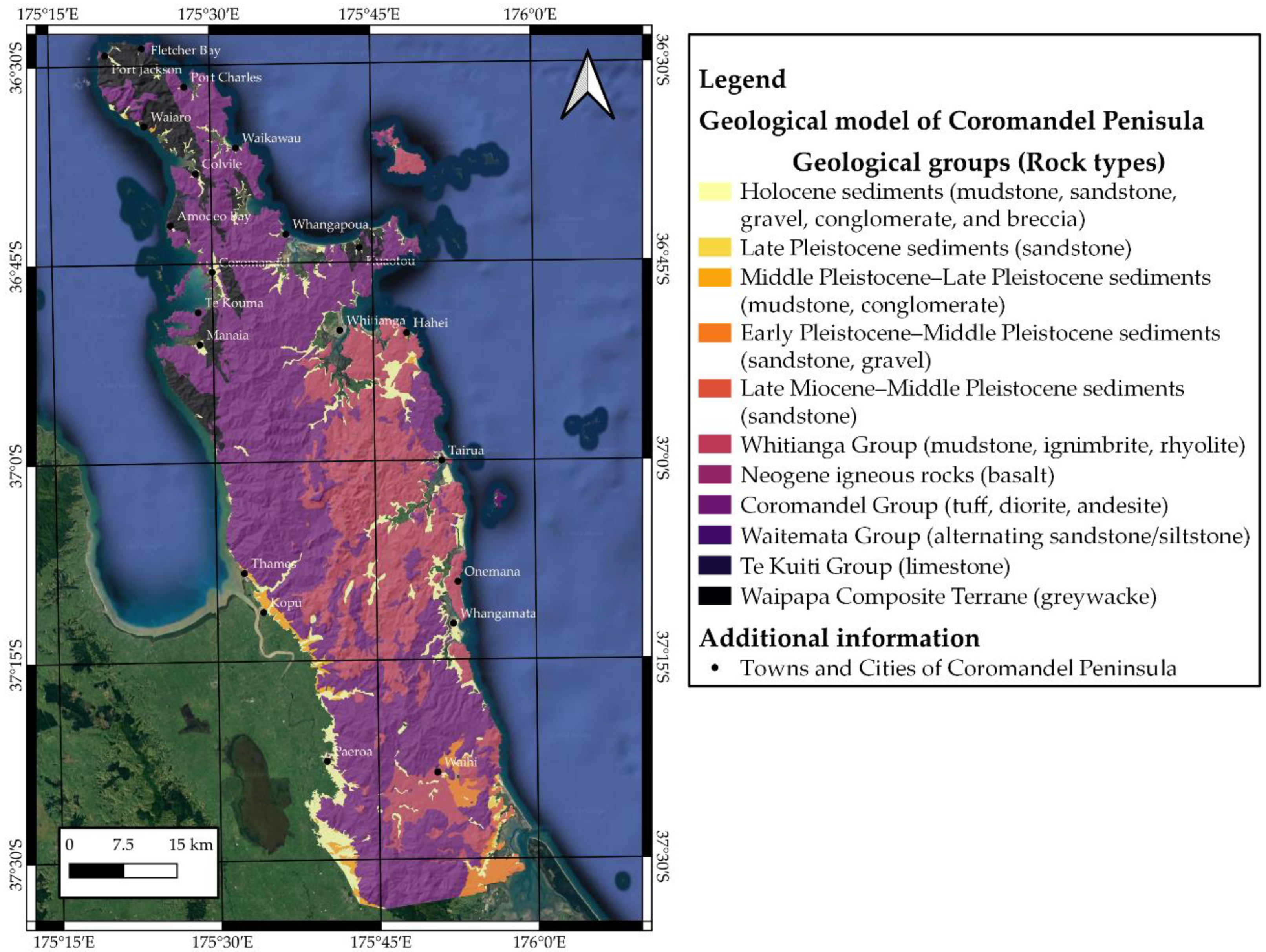
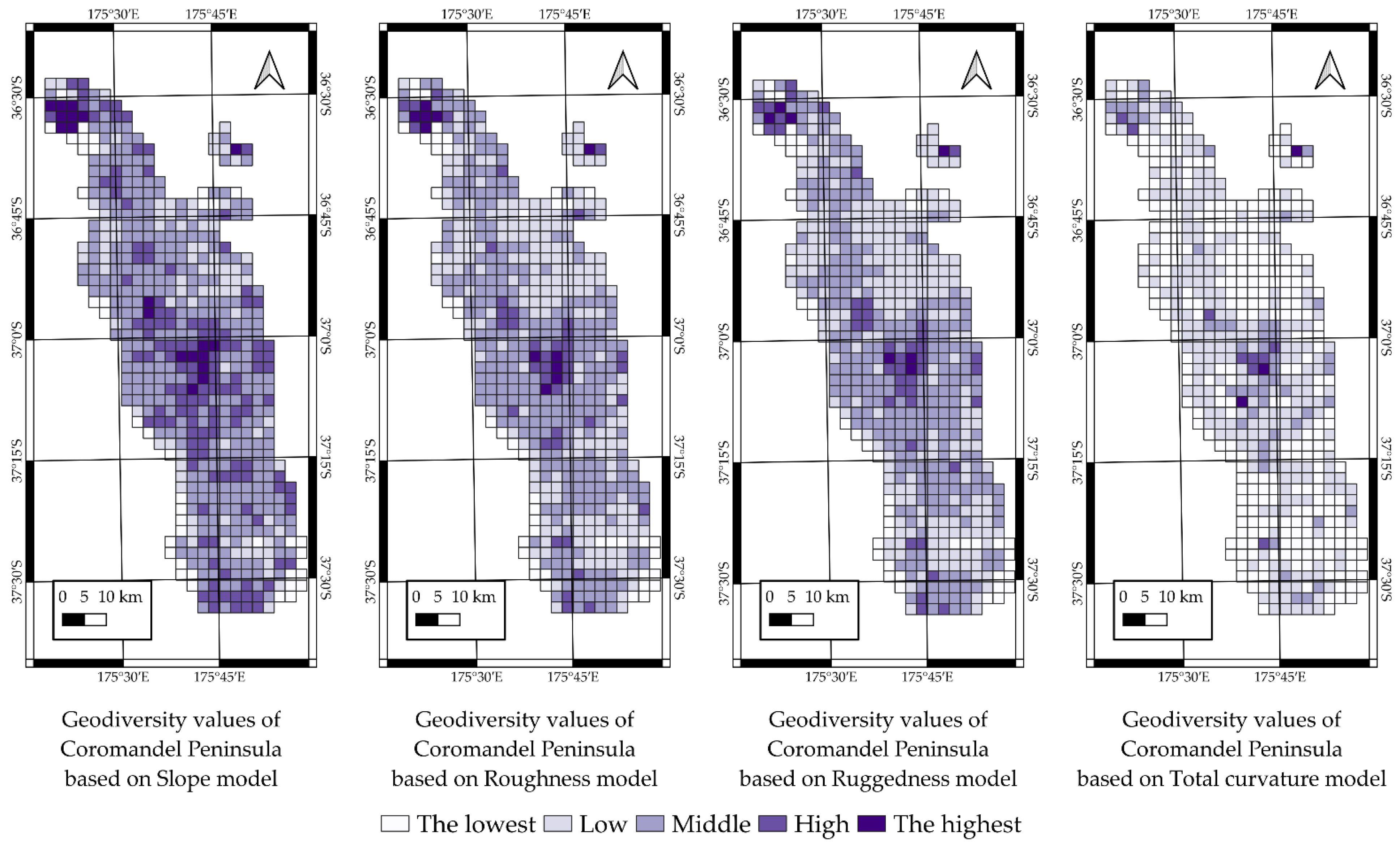
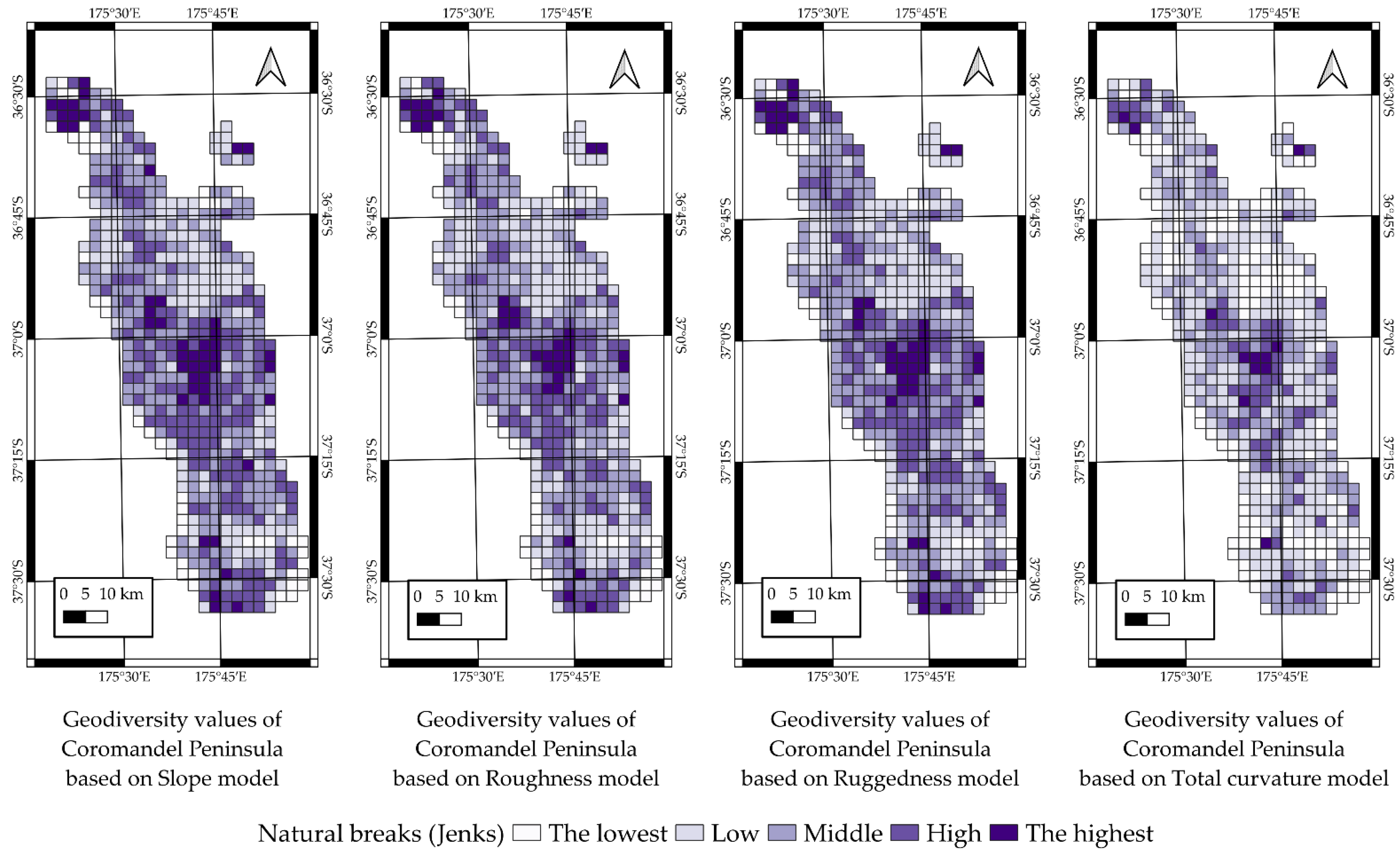
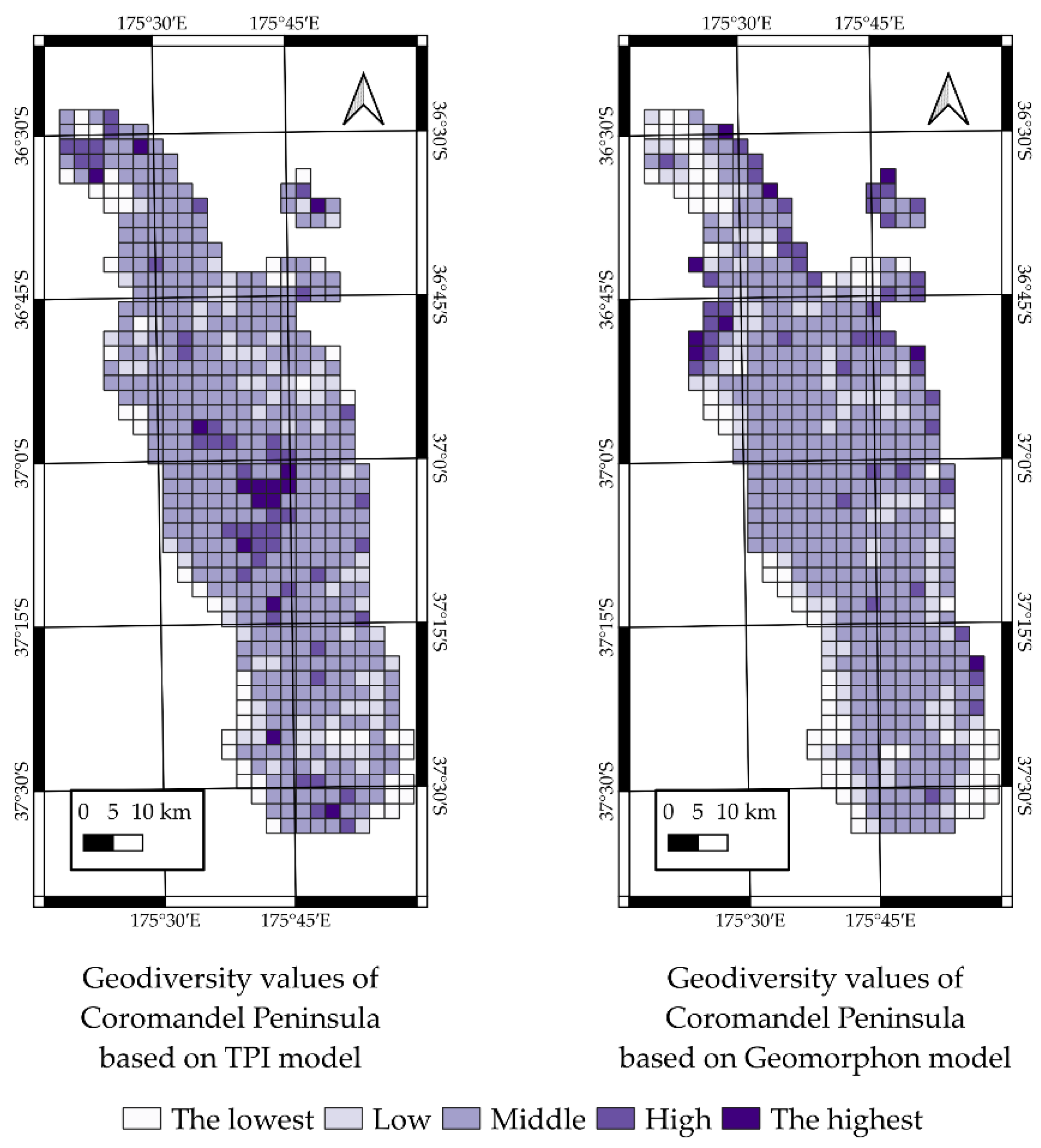
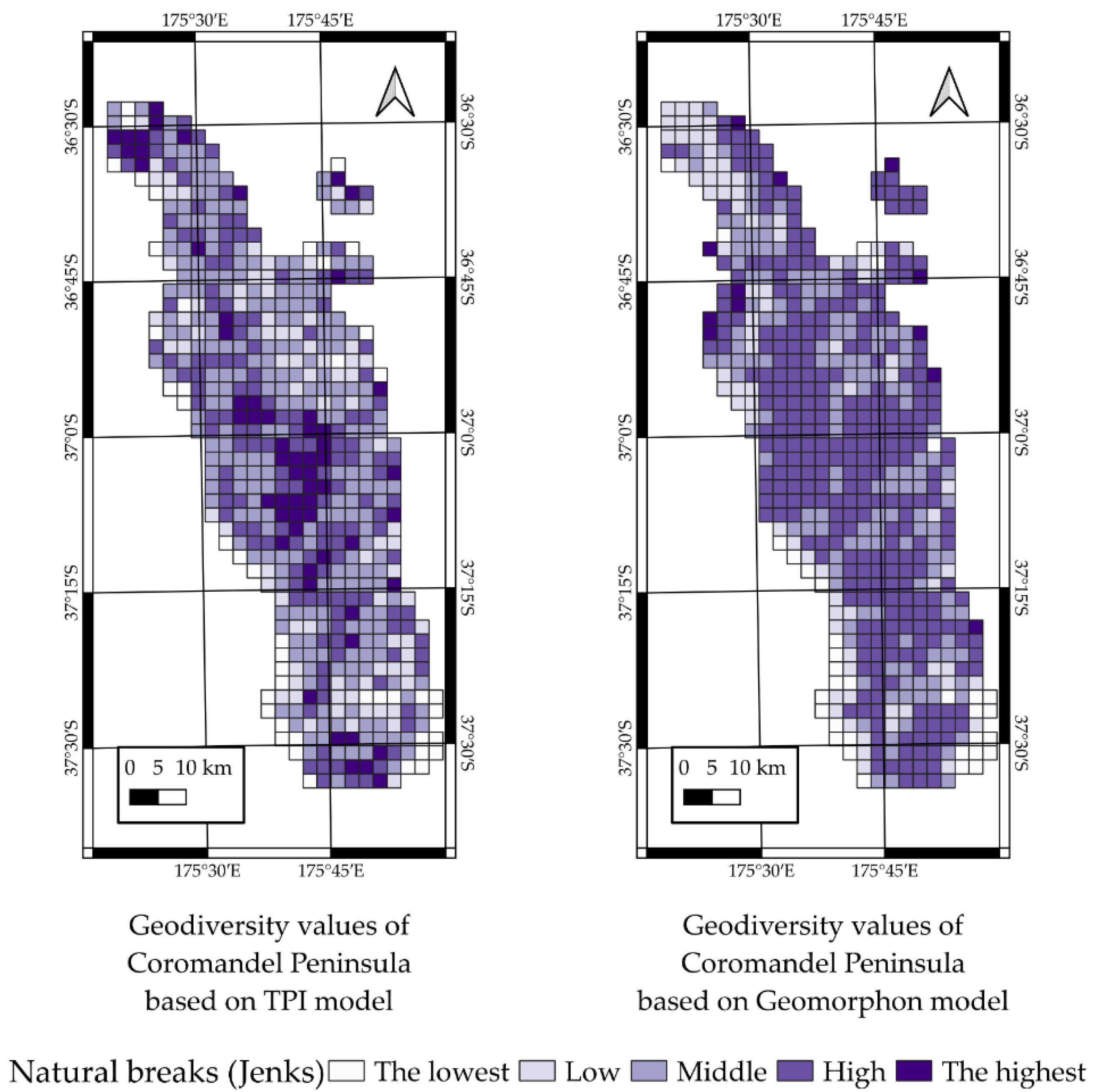


| Main Values of Geodiversity | ||||
|---|---|---|---|---|
| Values (7-Point System) | Elements of Geodiversity | |||
| Geomorphology | Geology | |||
| Slope, Roughness, Ruggedness, Total Curvature | Topographic Position Index | Geomorphon | Rock Type and Ages | |
| 1 (the lowest) | The numerical models have been included into assessment without direct evaluation. | Topographic Position Index model have been evaluated by 7-point system for positive and negative forms of landscape, where 0 is the lowest value | Flat and Slope | Sedimentary Cenozoic |
| 2 (low) | Hollow and Spur | Sedimentary Mesozoic | ||
| 3 (low to middle) | Footslope and Shoulder | Sedimentary Paleozoic | ||
| 4 (middle) | Valley and Ridge | Metamorphic Precambrian | ||
| 5 (middle to high) | Depression and Summit | Intrusive Precambrian | ||
| 6 (high) | 5-point system | Extrusive Cenozoic | ||
| 7 (the highest) | Extrusive Mesozoic | |||
| 8 (the rarest) Only Rocks | Sedimentary (Precambrian), Metamorphic and Intrusive (Cenozoic, Mesozoic, Paleozoic), Extrusive (Paleozoic, Precambrian) | |||
| Eras | Crystalline | Sedimentary | No. of Usable Data Points | |||
|---|---|---|---|---|---|---|
| Extrusive | Intrusive | Metamorphic and “Precambrian” | Total | |||
| Cenozoic | 4 | 0 | 0 | 4 | 33 | 290 |
| Mesozoic | 2 | 1 | 1 | 4 | 18 | 177 |
| Paleozoic | 1 | 1 | <1 | 2 | 13 | 117 |
| Precambrian | 0 | 6 | 15 | 21 | 1 | 173 |
| Age unknown | 1 | 1 | 1 | 3 | 1 | 26 |
| Total | 8 | 9 | 17 | 34 | 66 | 783 |
| Similarities (%) | Roughness | Ruggedness | Total Curvature | TPI | Geomorphon |
|---|---|---|---|---|---|
| Slope | 58.2 | 54.2 | 8.6 | 65.7 | 49.5 |
| Geomorphon | 54.0 | 54.0 | 22.9 | 57.9 | |
| TPI | 62.4 | 61.4 | 11.7 | ||
| Total curvature | 18.2 | 20.1 | |||
| Ruggedness | 91.4 |
| Similarities (%) | Roughness | Ruggedness | Total Curvature | TPI | Geomorphon |
|---|---|---|---|---|---|
| Slope | 84.3 | 93.4 | 33.2 | 56.6 | 37.4 |
| Geomorphon | 34.6 | 34.6 | 24.1 | 38.6 | |
| TPI | 52.1 | 58.4 | 19.1 | ||
| Total curvature | 41.3 | 36.4 | |||
| Ruggedness | 87.1 |
| Field Observation Sites | Slope | Roughness | Ruggedness | Total Curvature | TPI | Geomorphon |
|---|---|---|---|---|---|---|
| 1 | 1 | 1 | 1 | 8 | 0 | 0 |
| 2 | 9 | 16 | 13 | 20 | 7 | 7 |
| 3 | 28 | 24 | 25 | 22 | 22 | 21 |
| 4 | 10 | 14 | 11 | 5 | 23 | 28 |
| 5 | 8 | 1 | 6 | 1 | 4 | 0 |
| Total | 56 | 56 | 56 | 56 | 56 | 56 |
| Geopreservation Sites | Slope | Roughness | Ruggedness | Total Curvature | TPI | Geomorphon |
|---|---|---|---|---|---|---|
| 1 | 3 | 3 | 3 | 12 | 2 | 5 |
| 2 | 17 | 23 | 19 | 34 | 11 | 11 |
| 3 | 25 | 23 | 24 | 14 | 30 | 24 |
| 4 | 19 | 19 | 19 | 10 | 22 | 36 |
| 5 | 12 | 8 | 11 | 6 | 11 | 0 |
| Total | 76 | 76 | 76 | 76 | 76 | 76 |
Publisher’s Note: MDPI stays neutral with regard to jurisdictional claims in published maps and institutional affiliations. |
© 2022 by the authors. Licensee MDPI, Basel, Switzerland. This article is an open access article distributed under the terms and conditions of the Creative Commons Attribution (CC BY) license (https://creativecommons.org/licenses/by/4.0/).
Share and Cite
Zakharovskyi, V.; Németh, K. Geomorphological Model Comparison for Geosites, Utilizing Qualitative–Quantitative Assessment of Geodiversity, Coromandel Peninsula, New Zealand. Geographies 2022, 2, 609-628. https://doi.org/10.3390/geographies2040037
Zakharovskyi V, Németh K. Geomorphological Model Comparison for Geosites, Utilizing Qualitative–Quantitative Assessment of Geodiversity, Coromandel Peninsula, New Zealand. Geographies. 2022; 2(4):609-628. https://doi.org/10.3390/geographies2040037
Chicago/Turabian StyleZakharovskyi, Vladyslav, and Károly Németh. 2022. "Geomorphological Model Comparison for Geosites, Utilizing Qualitative–Quantitative Assessment of Geodiversity, Coromandel Peninsula, New Zealand" Geographies 2, no. 4: 609-628. https://doi.org/10.3390/geographies2040037






